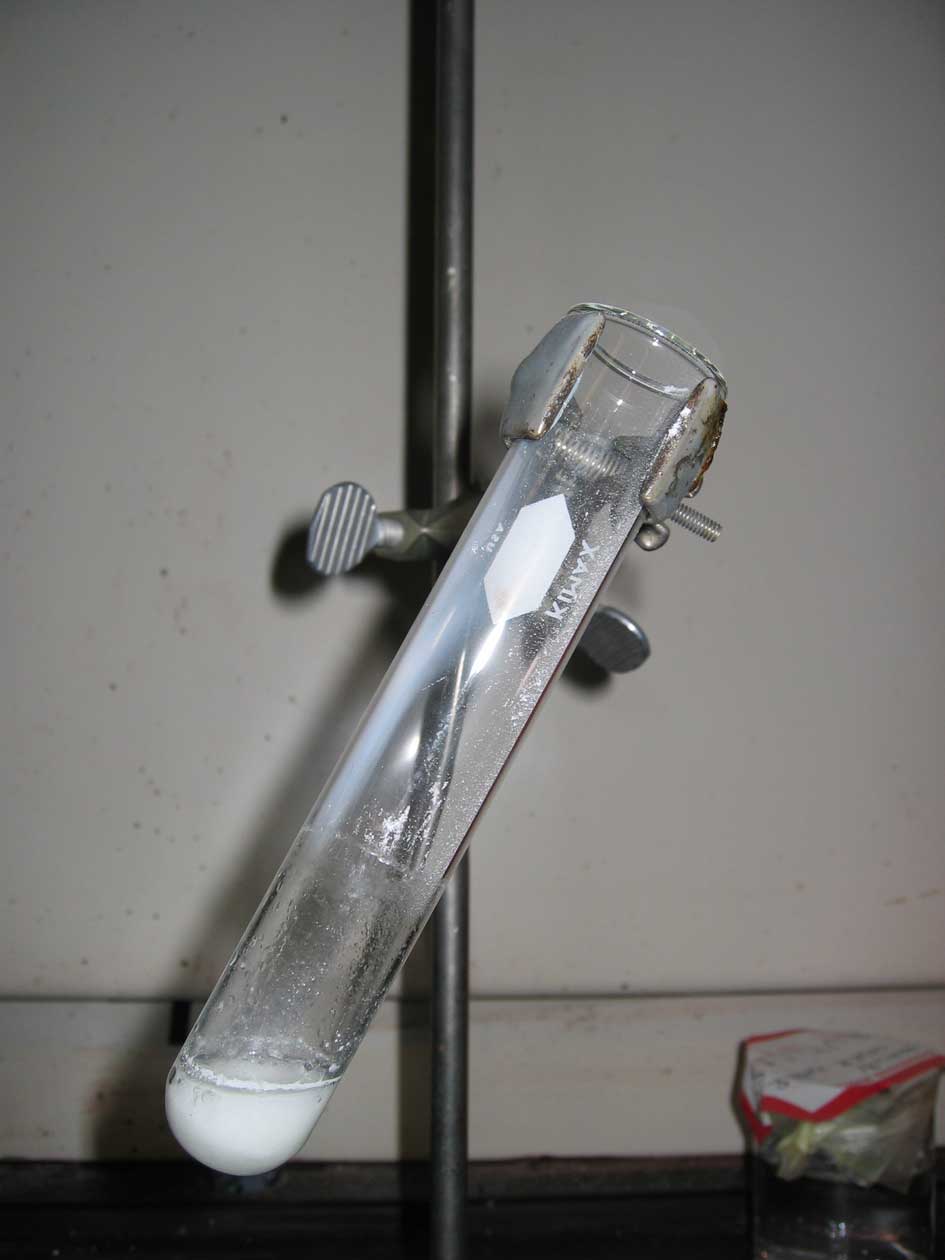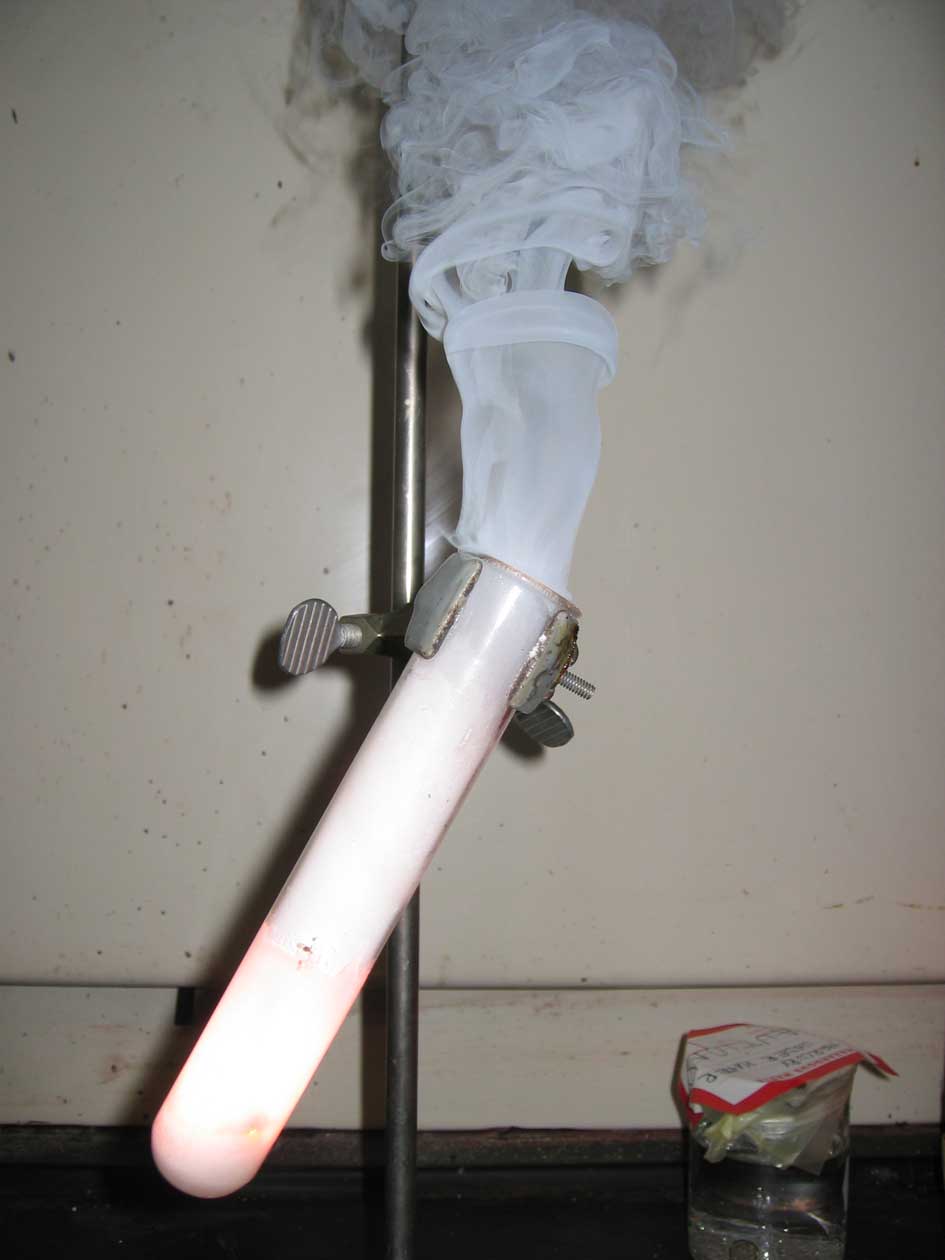Gummy bear exploration of molten salt world ends in tragedy
 A salt of potassium chlorate is melted. A "gummy bear" is added to the molten salt and dramatically "vaporized."
A salt of potassium chlorate is melted. A "gummy bear" is added to the molten salt and dramatically "vaporized."
Ingredients: potassium chlorate, propane torch, gummy bears, test tube
Procedure: A complete recipe follows.
1. Place a small quantity of potassium chlorate in a test tube.
2. Heat the solid salt until it becomes molten, demonstrating the high melting point of ionic solids.
3. Heat the solid further until it decomposes.
4. Add a small bit of a gummy bear to the test tube and observe the reaction.
Understanding: Our experience with salts is that they are solids. They tend to smell little or not at all. Many salts are found to be soluble in water. These characteristics of salts are explained by the great strength of the attractive ionic interactions between cations and anions that form the salt. The ionic attractions are far greater than the force of collisions between atoms and molecules at room temperature, so salts are typically solids. The salt ions do not leave the surface of the solid in an appreciable quantity, so the salt has little or no smell. However, when the salt is introduced to a polar solvent like water, the ions separate and the salt is soluble.
 The ionic forces between potassium, K+, and chlorate, ClO3-, ions are quite strong. At room temperature and pressure, the salt exists as a solid. At one atmosphere of pressure, the melting point is 368C (694F) which is far above room temperature
The ionic forces between potassium, K+, and chlorate, ClO3-, ions are quite strong. At room temperature and pressure, the salt exists as a solid. At one atmosphere of pressure, the melting point is 368C (694F) which is far above room temperature
KClO3(s) → KClO3(l)
The salt can be made to melt with a propane torch. At a temperature of 400C (752F) the potassium chlorate decomposes to produce molecular oxygen and potassium chloride salt
2 KClO3(l) → 2 KCl(s) + 3 O2(g)
The molten salt is relatively stable and unreactive with the surrounding air. However, it is quite reactive with the gummy bear! We can think of the gummy bear as a source of sugar, which we can represent simply in terms of the approximate empirical formula CH2O. The potassium chlorate is a rich source of oxygen gas, while the gummy bear is a source of carbon.
You will recall that potassium nitrate is a similar source of molecular oxygen and also a commonly used component of rocket fuel and gun powder.
The reaction is quite violent and produces a great deal of heat, white smoke, and pinkish-purple light. The color of the light is familiar to us, from the reaction of metallic potassium with water. The detection of the color is an excellent flame test for the presence of potassium in a compound.
The mixture of potassium chlorate and sugar is a simple form of sugar rocket fuel. Potassium chlorate mixed with charcoal is a common component of fireworks as it is a good source of heat and gas. It can be used as a propellant and as a source of heat to make colored fires.
The chemistry of gummy bear immolation
Question: Assume that the reaction of the potassium chlorate with the gummy bear results in products of water, carbon dioxide, and potassium chloride. Take the chemical formula of the gummy bear to be glucose sugar, C6H12O6. Write the balanced equation for the reaction.Draw Lewis "electron dot" structures for each of the reactants and products in the overall reaction. Determine the structure of each molecule. Note whether each molecule is charged, polar, or nonpolar. The cyclohexane molecule is known to have a few relatively unstrained molecular structures. One is known as the "chair" and another the "twist boat." Using your knowledge of molecular structure (and your molecular model kit), identify those structures.